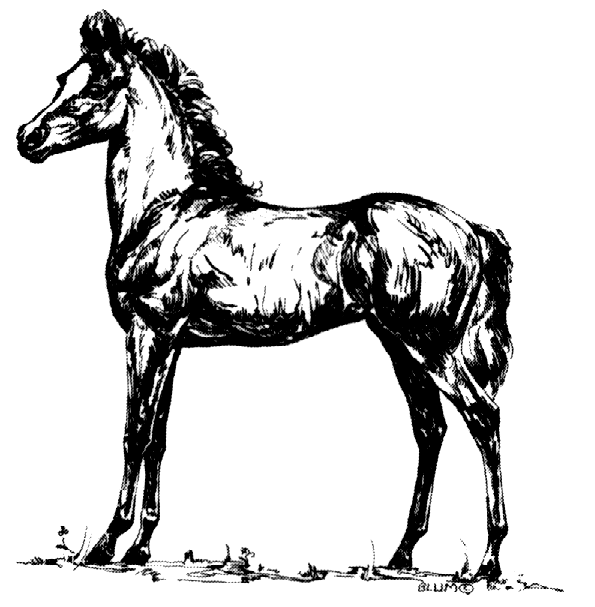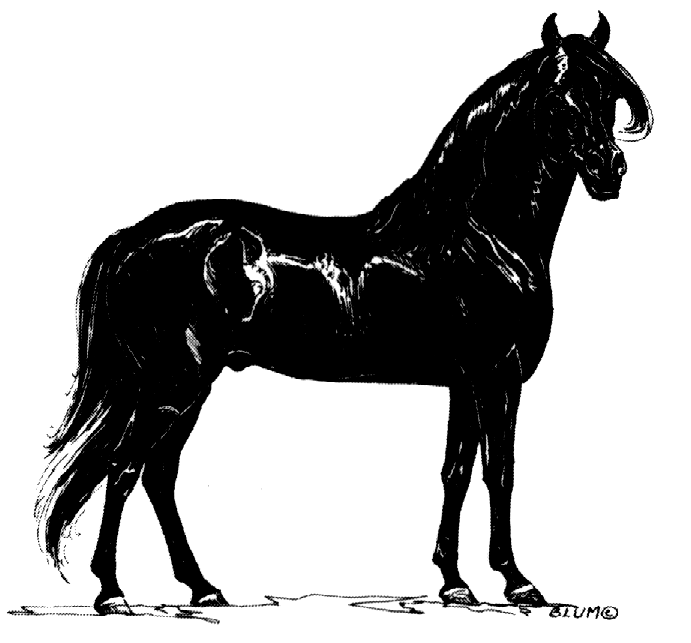The hybrid effect, achieved in the past by crossing
the separate strains of Peruvian horses, produces an animal more vigorous
than either of the pure-stram parents. They are oRen fast-maturing animals
that attain more size than might be expected from the mating. They are hardy
with few health problems, good bloom and usually all the athletic ability
that could come from the breeding. All these effects are more pronounced
in the first cross (F1 generation) than in subsequent (F2 and F3) crosses.
As breeding animals, F1 hybrids are not usually
able to reliably pass on their outstanding characteristics. Howeverin the
Peruvian breed one can find a percentage of hybrids that are surprisingly
prepotent, probably because their sires and dams though unrelated had many
characteristics in common (i.e. Iike to like). It should be noted that the
infusion of more than two strains into a hybrid breeding program will greatly
reduce the breeder's ability to predict the characteristic of his produce.
It will add any generations to the number required to form a uniform herd.
To have optimum success, a hybrid breeder must stay with just two strains
and try to maintain close to a 50-50 percentage in all of his animals until
his new type is set.
An example of a hybrid program for purebred Peruvian
horses is the one the author began after three years of breeding, in 1977.
Having chosen Cayalti (northern) mares which that were middle aged at that
time, they were crossed with the pure Southern stallion *Piloto,
one of the only southern stallions which allowed the fine gait of a mare
to come through. The offspring resulting from those crosses, Soberano++,
La Poetica, Porcelana CM, and Flor de Tejas, were bred to others
like them such as *Su Senoria, a 50-50 stallion
by Sol de Oro V out of a Torre
Ugarte (northern) mare. The F2 and F3 horses, such as
Sobrante CM+ and Mercedes CM++, were
still 50-50 with much the same qualities of their parents. Other examples
of hybrid breeding programs were those of Jose Antonio Onrubia, Anibal Vazquez,
Raul Risso and recently Manuel Sanchez. After two or three generations of
hybridization, a type will begin to emerge.
Breeding like to like
increases the chance that an offspring will have the characteristics of
its parents and be prepotent as a breeding animal. When used as the sole
breeding system, without regard for pedigree, it will not be very effective
in producing a type. However, when used in conjunction with any other method,
be it linebreeding, outcrossing or hybridization, it will improve herd uniformity
and decrease the number of generations required to create a type. A breeder
should always be mating Like to Like to an extent. The most knowledgeable
breeders consider it unwise to mate extremes. For example, one should not
breed a mare without terming to a stallion with maximum terming, since then
it would be difficult to predict the inheritance of future generations.
It would be preferable to breed the mare to a prepotent stallion with moderate
and perfectly correct terming, hoping for a daughter better than the mare.
One should breed toward the ideal, but expect moderate, consistent improvement
with each generation.
A case where breeding extremes is justified is where
there is an urgent need to improve strength. If the pastern or the back
of a mare is too long, breeding to a stallion that is very short in those
areas will make dramatic improvement. The resulting offspring should then
be bred to the ideal to continue the quest for strength.
An outstanding example of a "like to like"
breeding program which then evolved into a set "type" was the
program of Jose Musante H.
Sr. Musante explained to the author in 1977 how
he had created exactly the Peruvian horse he wanted. Once his type was set,
he explained how he would outcross one generation and then go back to the
family for the next generation. Alternating generations in this way kept
Sr. Musante's herd from becoming inbred, while maintaining his preferred
type. He was so successful in setting his type that during the seventies
it was widely known that when a Musante horse was crossed with any other
Peravian line, the result would still look like a Musante horse.
The effects of inbreeding
and linebreeding are similar.
Their aims are to produce horses that are of a type and which can reliably
reproduce their characteristics in their offspring. This occurs quickly,
because in linebreeding to a particular ancestor the chance that the ancestor's
genetic material will be present in the foal is greatly increased. Family
breeding, when practiced properly, can be a powerful tool in "setting"
desirable characteristics in a herd.
Inbreeding and linebreeding are used by many breeders
of Peruvian horses. Several of the breed's most outstanding horses have
resulted from linebreedings. For example, the legendary *Piloto resulted
from the mating of half-brother to half-sister, both his parents having
been sired by the same stallion. This information was only documented in
the late 1980's and helped explain why *Piloto was so prepotent. It also
explained why *Piloto was so valuable in a "hybrid" program -the
North-South cross with Cayalti and Pucala mares. This information was significant
at that time because many people were doing intense linebreedings to *Piloto
without knowing that he himself was already closely linebred. |

 A
little linebreeding can help a breeder who is willing to analyze objectively.
The breeder must cull ruthlessly and use disappointing breedings to learn
which crosses to avoid.
A
little linebreeding can help a breeder who is willing to analyze objectively.
The breeder must cull ruthlessly and use disappointing breedings to learn
which crosses to avoid.